Yellow-lipped Sea Krait
- December 17, 2023
- 0 comment
The Yellow-lipped Sea Krait, scientifically known as Laticauda colubrina, is a fascinating and visually striking marine snake found in the warm coastal waters of the Indian and Pacific Oceans. This species is renowned for its distinctive appearance, characterised by a vibrant yellow coloration on its upper lip, which starkly contrasts with the rest of its dark-colored body.
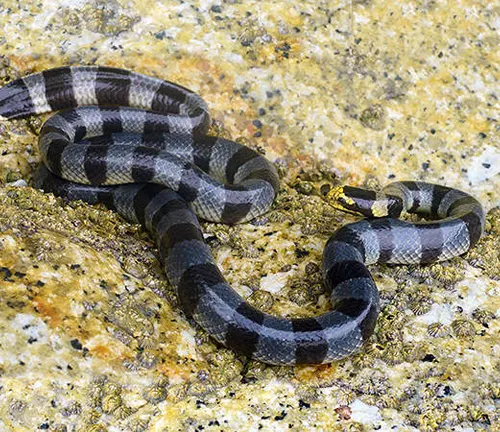
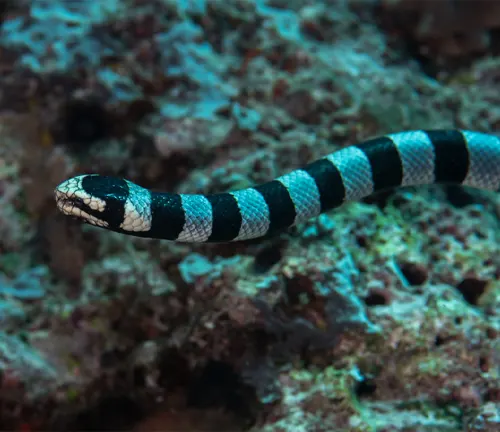
Growing up to 1.2 meters in length, the Yellow-lipped Sea Krait possesses a sleek and slender build, well-adapted for a predominantly aquatic lifestyle. Despite its snake classification, this creature has evolved to be an excellent swimmer, propelling itself through the water with remarkable agility. Adept at both underwater and surface navigation, the Yellow-lipped Sea Krait is known to venture into shallow coral reefs and mangrove areas, preying on small fish and eels using its potent venom.
While these snakes are venomous, they are generally docile and pose minimal threat to humans unless provoked. As air-breathing reptiles, Yellow-lipped Sea Kraits regularly surface to breathe, and interestingly, they often return to land to digest their meals. Conservation efforts are essential to protect these unique creatures, as they face various threats, including habitat loss and pollution in their coastal environments. Studying the Yellow-lipped Sea Krait provides valuable insights into the adaptations of marine reptiles and contributes to our understanding of the delicate balance within coastal ecosystems.
| Characteristic | Description |
|---|---|
| Scientific Name | Laticauda colubrina |
| Size | Up to 1.2 meters in length |
| Coloration | Dark-colored body with a vibrant yellow upper lip |
| Distribution | Warm coastal waters of the Indian and Pacific Oceans |
| Habitat | Coral reefs, mangroves, and shallow coastal waters |
| Locomotion | Excellent swimmer with agility in both water and on land |
| Diet | Feeds on small fish and eels, using venom for prey capture |
| Venom | Venomous but generally docile; poses minimal threat to humans unless provoked |
| Breathing | Air-breathing reptile; surfaces regularly for breathing |
| Behavior | Returns to land to digest meals |
| Conservation Status | Faces threats such as habitat loss and pollution |
| Importance | Provides insights into marine reptile adaptations and contributes to coastal ecosystem understanding |
Venomous or Not Venomous?
The question of venom is often a point of intrigue for those exploring the world of sea snakes. The Yellow-Lipped Sea Krait, while indeed venomous, exhibits a docile nature, posing minimal threat to humans unless provoked. Understanding the intricacies of its venomous adaptations adds a layer of fascination to this marine creature, showcasing the delicate balance between survival instincts and coexistence with other species.

Ecological Importance
Delving into the ecological realm, the Yellow-Lipped Sea Krait plays a crucial role in maintaining the balance of coastal ecosystems. As a predator, it preys on small fish and eels, contributing to the regulation of the marine food chain. Its presence in coral reefs and mangrove areas reflects the interconnectedness of species within these delicate environments, emphasizing the significance of preserving their biodiversity.
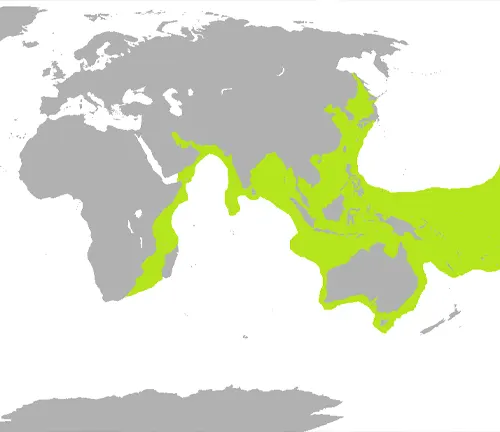
Habitat
Exploring the habitat preferences of the Yellow-Lipped Sea Krait reveals its affinity for warm coastal waters, specifically in the proximity of coral reefs and mangroves. This preference reflects the species’ adaptation to specific environmental conditions and highlights the vulnerability of these habitats to anthropogenic threats such as pollution and habitat loss.
Behavior
A study of the Yellow-Lipped Sea Krait’s behavior reveals a fascinating dual life – equally adept at swimming and navigating on land. With remarkable agility, these marine snakes gracefully move through the water, making them efficient hunters. Their unique behavior also includes returning to land for digestion, showcasing a multifaceted adaptation to both aquatic and terrestrial environments.
Art and Culture
Beyond its ecological role, the Yellow-Lipped Sea Krait has found its way into the tapestry of art and culture in the regions it inhabits. Depictions of this striking sea snake in local art and folklore reflect the intertwining of human lives with the diverse marine life that surrounds them, adding a cultural layer to the understanding of this fascinating species.
Survival
Survival strategies of the Yellow-Lipped Sea Krait involve not only its venomous capabilities for hunting but also its ability to navigate and thrive in dynamic coastal environments. Examining the intricacies of its survival mechanisms sheds light on the resilience of this species in the face of various challenges posed by its natural habitat and human activities.
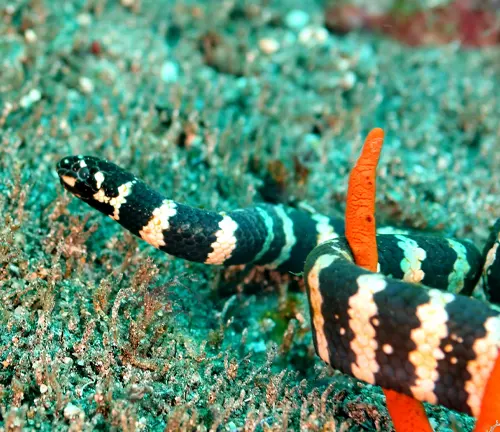
Conservation
Despite its adaptability, the Yellow-Lipped Sea Krait faces threats, including habitat loss and pollution. Conservation efforts are imperative to safeguard these unique marine creatures and the ecosystems they inhabit. Understanding the ecological importance and vulnerabilities of the Yellow-Lipped Sea Krait is crucial for formulating effective conservation strategies.
Common Food

A look into the dietary habits of the Yellow-Lipped Sea Krait reveals a menu predominantly consisting of small fish and eels. The efficient hunting techniques and dietary preferences of this species contribute to the intricate web of interactions within its ecosystem, showcasing its role as a predator in maintaining a healthy marine environment.
Benefits
Beyond its ecological contributions, the Yellow-Lipped Sea Krait offers benefits to humans through scientific research and education. Studying its unique adaptations provides valuable insights into marine reptile biology, contributing to our understanding of the broader field of herpetology. Furthermore, education initiatives cantered around these intriguing creatures foster a deeper appreciation for marine biodiversity and conservation efforts.
Different Species
Laticauda colubrina
Commonly known as the Yellow-lipped Sea Krait, this species is widely distributed in the Indian and Pacific Oceans, including regions such as Southeast Asia, Australia, and the Pacific Islands.

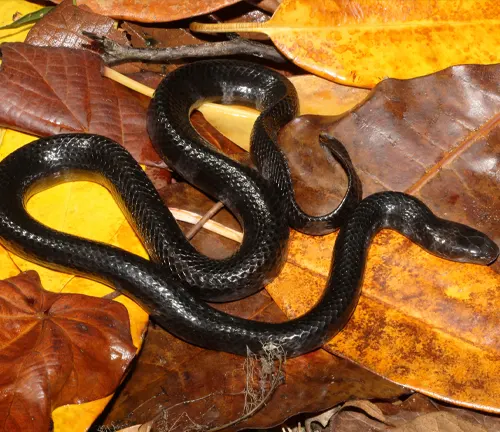
Laticauda crockeri
Also referred to as Crocker’s Sea Krait, this species is found in the waters of the Philippines and parts of Indonesia. It shares some similarities with the Yellow-lipped Sea Krait but may have distinguishing features.
Laticauda frontalis
Known as the Annulated Sea Krait, this species inhabits the waters of the western Pacific, including areas around Papua New Guinea and the Solomon Islands. It is recognised by its distinctive banded pattern.
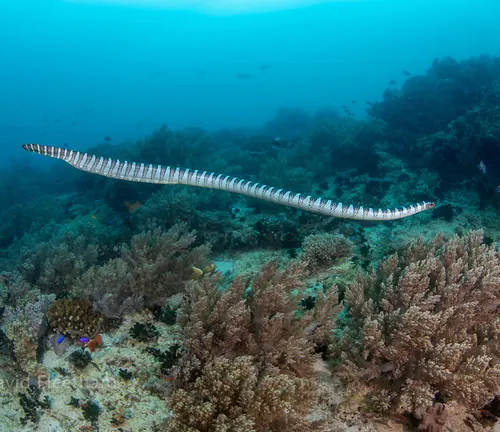
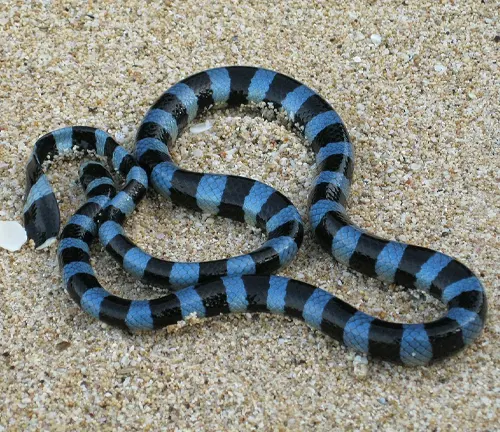
Laticauda guineai
Found in the waters of Papua New Guinea, this species is commonly called the New Guinea Sea Krait. It shares habitats with other sea krait species but has its own ecological niche.
Laticauda saintgironsi
This species, known as Saint Girons’ Sea Krait, is found in the waters of New Caledonia. It is named after French herpetologist Jean Saint Girons.
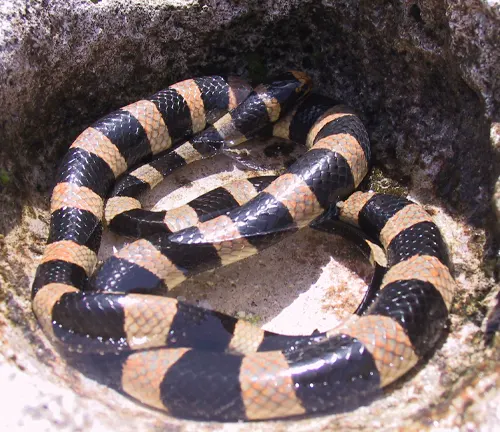
Conclusion
In conclusion, the Yellow-Lipped Sea Krait emerges not only as a captivating botanical beauty but also as a vital player in the intricate dance of coastal ecosystems. From its venomous adaptations to its cultural significance, this marine snake embodies the interconnectedness of nature and human societies. As we navigate the waters of conservation, understanding and appreciating the Yellow-Lipped Sea Krait’s role in its habitat becomes paramount for the preservation of these unique and fragile ecosystems.
Frequently Asked Questions (FAQs)
1. What is the Yellow-lipped Sea Krait?
The Yellow-lipped Sea Krait (Laticauda colubrina) is a species of sea snake found in the warm coastal waters of the Indian and Pacific Oceans. It is known for its distinctive yellow upper lip and is part of the Laticauda genus.
2. Is the Yellow-lipped Sea Krait venomous?
Yes, the Yellow-lipped Sea Krait is venomous. However, it is generally considered docile and poses minimal threat to humans unless provoked.
3. What is the habitat of the Yellow-lipped Sea Krait?
These sea snakes prefer warm coastal waters, including coral reefs and mangroves. They are known to frequent shallow areas near the shore.
4. How big do Yellow-lipped Sea Kraits get?
Yellow-lipped Sea Kraits can grow up to 1.2 meters in length, making them a relatively small species of sea snake.
5. What is their diet?
They primarily feed on small fish and eels. They are skilled hunters, using their venom to subdue prey.
6. How do Yellow-lipped Sea Kraits breathe?
Being air-breathing reptiles, Yellow-lipped Sea Kraits need to surface regularly to breathe. Despite their aquatic lifestyle, they are not adapted to prolonged underwater stays.
7. Are Yellow-lipped Sea Kraits endangered?
Conservation status may vary, but some populations face threats from habitat loss and pollution. Conservation efforts are crucial to protecting these unique marine creatures.
8. Do Yellow-lipped Sea Kraits come on land?
Yes, Yellow-lipped Sea Kraits return to land for digestion. This behaviour sets them apart from fully marine species, showcasing their adaptability to both aquatic and terrestrial environments.
9. How are Yellow-lipped Sea Kraits culturally significant?
These sea snakes are sometimes featured in local art and folklore in regions where they are found, adding a cultural dimension to their significance.
10. What role do Yellow-lipped Sea Kraits play in the ecosystem?
Yellow-lipped Sea Kraits contribute to the balance of coastal ecosystems by preying on small fish and eels, helping regulate the marine food chain.
11. Can Yellow-lipped Sea Kraits be kept as pets?
Keeping sea snakes, including Yellow-lipped Sea Kraits, as pets is not recommended. They have specific habitat and dietary requirements that are challenging to meet in captivity, and their venomous nature poses risks.
12. Are Yellow-lipped Sea Kraits found in specific regions?
Yes, Yellow-lipped Sea Kraits are commonly found in the waters of Southeast Asia, Australia, and the Pacific Islands.


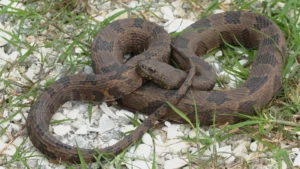



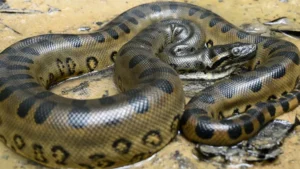
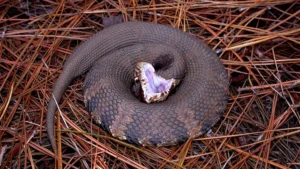
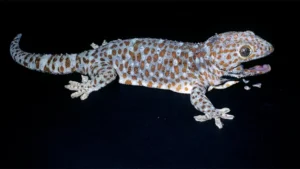


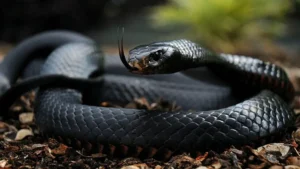
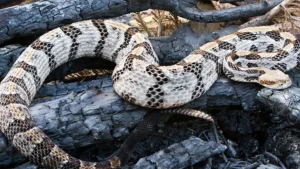
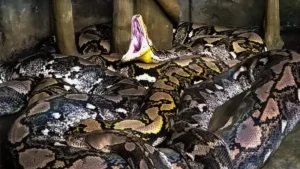
Leave your comment